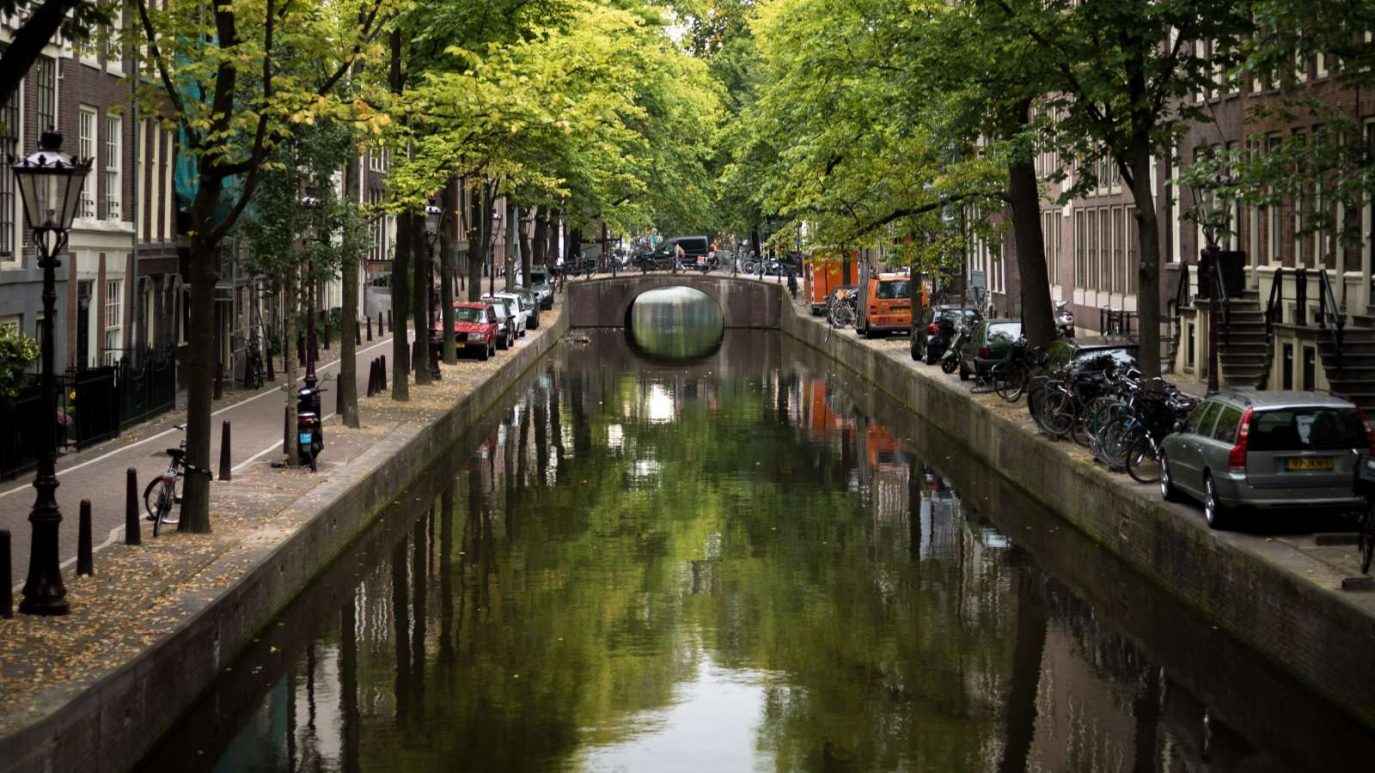Perched on the Vatican Hill in Vatican City, St. Peter’s basilica can easily qualify for the title of the most impressive building in Rome. This is the site where the Holy St Peter ….principal of Jesus’s apostles and the founder of the Christian Church is buried so you can imagine the symbolic importance of this site. Not every church becomes a basilica; a church becomes a basilica only when it’s designated by the Pope or it obtains a sacred relic.
There are more than 14,000 such basilicas all over the world but they are ‘minor’. St Peters Basilica is one amongst the 4 major basilicas in the world and the rest of the 3 (incidentally all are based in Rome) are St Mary Maggiore, St John Lateran and St Pauls. As of now it’s the second largest church in the world; its interiors can easily swallow two soccer fields.
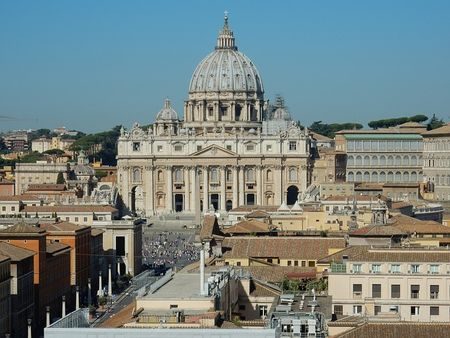
The Story of Saint Peter
Post the crucification of Christ, it was Saint Peter who played a principal role of leadership. It said in the holy book ‘Acts of Apostle’ that Simon who was originally a fisherman from Galilee gained a position of supremacy amongst the Apostles. St Peter went on to play a major role in founding the Christian church. Simon’s steadfast loyalty to Jesus urged the latter to bestow the name Petrus (means rock in Greek) on him.
St Peter played an instrumental role in establishing the foundations of Christian church and served a ministry for 34 years before he travelled to Rome and met his end there along with St Paul on 13th October in 64 AD under the cruel emperor Nero’s rule. It’s said that the execution of St Peter was one of the reasons behind the Great Fire of Rome. At his own request St Peter was crucified with his head pointing downwards as he considered himself unworthy of being crucified in the same manner as Jesus. The crucifixion took place near an old Egyptian obelisk and this now stands in St Peters Square and is considered to be one of the most sacred relics of Rome.
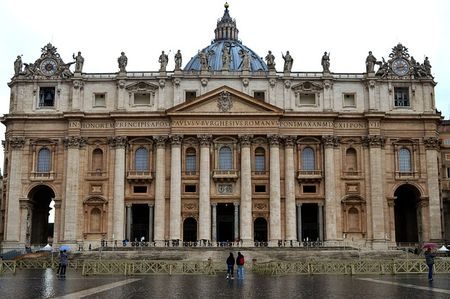
History says that the remains of St Peter were buried on the Vatican Hill across the Via Cornelia (this is near the St Peters Square) and a simple shrine was built at this point. Almost 300 years after his death, the original (old st Peters basilica) was built at this site. It’s also said that this zone in the Vatican City was a cemetery earlier before Nero’s infamous circus was built here (many horrible executions took place during his reign).
After the death of St Peter many Christians expressed a wish to be buried near him which is why this area became famous for burials. The Old Saint Peters Basilica was built in 4th century under the reign of Emperor Constantine. Its shape was estimated to resemble a cross and its contents comprised of a great quantity of burial remains and memorials that include most of the popes from St Peters (referred to as the first Pope of Christianity) to the 15th century. By the 15th century the basilica had crumbled under the ravages of time.
Tragic & Dramatic Construction of the Basilica
Many popes considered rebuilding the basilica and one of them was Pope Nicholas V. He commissioned Leone Alberti and Bernardo Rossellino to completely redesign the basilica and even ordered the demolition of the Coliseum for utilising its stone for the new Saint Peter’s basilica. Rossellino proposed that the old St Peter’s basilica be torn down and a completely new and grander church be erected. Nicholas V approved the idea and died soon after followed by Rossellino who also died a few years later. Only a new wall was built on the periphery of the original basilica till the year 1500.
It was with the looted stones of the Coliseum that many parts of the new St Peter’s basilica were built including a new transept, choir and nave refurbishments.
Pope Julius II was the first Roman Pope who incorporated a grand tomb adorned by Michelangelo’s sculpture inside St Peters and then instructed for his remains to be placed inside after his death; an act of obvious self-glorification. He finally had the entire old basilica demolished (erasing an important slice of history) and ordered a bigger structure to be built; a construct large enough to host his huge tomb (a pyramid shaped monument with 40 statues).
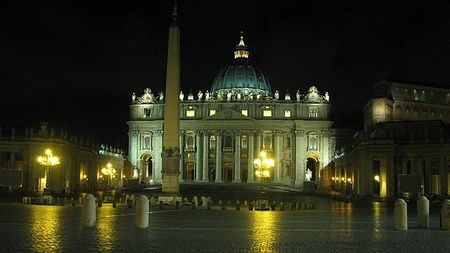
A competition was held for building the larger basilica and many marvellous designs were submitted by leading architects. A visit to the Uffizi gallery will show you some of those designs. A number of architects and popes followed the example of Pope Julius II and instructed for their remains to be placed inside grand tombs that were housed inside St Peters. Finally Donato Bramante’s design was selected and the foundation stone was laid in 1506. The design was obviously inspired from Pantheon and had a huge Greek cross shaped design with a huge dome ….a clear diversion from the Latin cross traditional design. However unlike the Pantheon, the St Peters basilica was supported on 4 big piers.
Incidentally both Bramante and Pope Julius II died a few years after the basilica foundation stone was set; they only managed to construct the 4 enormous pillars that would hold up the dome.
After the death of Pope Julius II, a team of Giuliano, Raphael and Fra Giocondo were chosen to build the new basilica. Raphael incorporated the striking nave with the 5 bays and apsidal chamber design but died soon after reaffirming the tragic fate of the architects of the basilica. Many other architects and designers succeeded Raphael and one major contribution was made by Antonio Sangallo who created a wooden model of the basilica (this itself took 8 years). You can view the model at the Basilica showcase inside.
The actual work began after 1547 when Michelangelo (he was 70 years old at this point) led the building project (much against his will) under the reign of Pope Paul III. Michelangelo’s student Giacomo Della Porta continued the construction of the Basilica after the formers death. Later Carlo Maderno extended the Church by creating a 3 nave structure (under the instructions of Pope Paul V). Finally 120 years after its foundation stone was laid….the basilica was completed on the 18th November 1626 and it was consecrated by Pope Urban VIII.
The interior work of the Church began thereafter and was mostly done by Gian Lorenzo Bernini. It was Bernini who created the St Peter’s throne, the magnificent floor, the baldacchino, the 4 bronze adorned pillars and the colonnades on St Peters square….thus making the basilica interiors worthy of its stature.
If you read its construction history in detail you will find that almost all major architects of the Baroque and Roman Renaissance period were a part of this project. The tragedies and controversies that the 120 year old construction period saw is the stuff of legends now.
Like most other Roman monuments the St Peters basilica was also restored. Car fumes and pollution had worn out the contours of the building and the basilica was perceived as ‘uniformly grey’ for years. A 5.4 million dollar restoration project that lasted from 1996 to 1999 and sparked huge controversies when it changed the buildings baroque façade to ‘straw colour’ and the central balcony frames was decorated in red and green.
Architectural critics have protested violently against the ‘dramatized version’ of the basilica while the restorers say that only the original renaissance period colours (as created by Carlo Maderno) had been restored!!! Check out the basilica and decide if you like the new look for yourself!!
What to See and Do
The gigantic Basilica can easily accommodate 20,000 people at one shot and always conveys an impression of space and artistic excellence. Each inch of the Basilica is worth seeing up close but here are the details of the principal features that you should look out for. And in front of the basilica is the famous St. Peter’s Square … a colossal open square that was built to house large number of people to hear the Pope and take his blessings.
Entrances
There are 5 separate entrances that lead to the lobby area of the church (also called Narthex) and right here you will find equestrian statues of Emperor Constantine and Charles the Great. 5 separate doors connect the narthex to the basilica nave. The most outstanding door is the central 15th century bronze door that was created by the Florentine sculptor and architect Filarete. On the right is the sacred Porta Santa door…. The sacred door of St Peters Basilica is opened only in the Jubilee years i.e. every 25 years.
Floor
The basilica floor is no less than a work of art; it has pretty marble patterns. There is striking red porphyry disc near the central door. This is a relic from the old basilica… In the old church the disc was placed in front of the principal altar. Roman emperors were crowned while they stood on the disc.
Baldacchino and Niches
Bernini had a huge role in determining the final look of the St Peters Cathedral as it stands today. His largest contribution was to design the baldacchino i.e. a pavilion like construct that is 94.3 feet tall and stands under the dome and above the altar. The baldacchino is designed to be a ciborium like holy space above and around the sacred table on which the sacrament is laid down.
Unlike usual ciborium that are made of white marble, Bernini’s creation was strikingly different. This baldacchino is inspired from the temples of Jerusalem and has 4 gorgeous bronze columns decorated with motifs like laurel leaves and bees (sign of Pope Urban). The baldacchino is surmounted with curved baroque brackets that support a draped canopy made of pure bronze with gold leaf inlays. The bronze used for this was looted from the ceiling and pediment of the Pantheon.
Look in front of the papal altar and you will see the sacred confession i.e. the burial crypt. This marks the grave of St Peter and it’s circled by a balustrade containing 95 bronze oil lamps.
Dome & The Viewing Platform
The Basilica building supersedes the definition ‘impressive’. Its nave is 211.5 meters long and has a stunning narthex (lobby). The Dome of St Peters is a stunning 136.57 meters in height including its external cross and is officially recognised as the tallest dome in the world. Its diameter is 41.47 meters that’s slightly more compact than two large domes that inspired it i.e. Pantheon and Early Renaissance Florence Cathedral.
Look directly above the Confessio and you can see the Dome stretching upwards. The Dome is popularly referred to as ‘a Michelangelo masterpiece’. The Dome rests on 4 huge 5 sided pillars. Triangular spaces are created where pillars meet the dome and these are decked with mosaics that represent the evangelists.
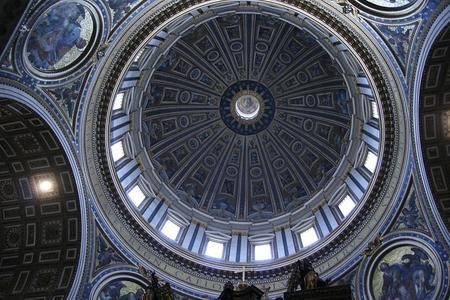
Atop the pillars there is a large cylindrical drum with 16 big rectangular windows; these act as support for the vault. The vault has ribs which later conjoined in an oculus and this holds a giant lantern. Light enters through the lanterns and the windows creating a beautiful spiritual effect.
The exteriors of the drum and lantern have dual Corinthian columns. It is at the base of the lantern where you will find the viewing platform….this gives visitors a fantastic view of Rome. For reaching the platform you can take the elevator or stairs. The stairs are antique, narrow and spiralling and require physical fitness to handle; they are sandwiched between inner and outer walls of the dome!!
You can walk up to the roof terrace of the Dome where you can admire the building more profoundly. There are galleries inside the dome that allow visitors a beautiful wide angle view of the church’s interiors. The view from the viewing platform is unparalleled; where else can you see two countries (Rome and Vatican City) in glorious detail at once!!
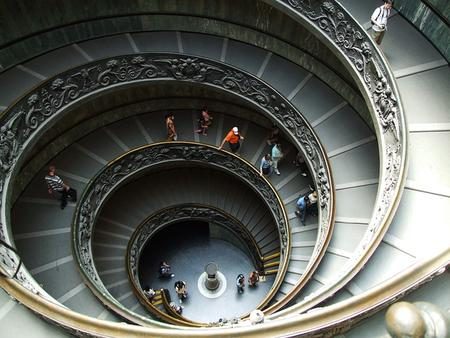
The gorgeous front façade is a Carlo Maderno-Michelangelo design that’s a study in sheer size and perfect symmetry. The façade is 45.5 meters high and has huge statues of Christ, Baptist John and all apostles apart from St Peter. Both sides of the façade have large clocks that are held in place by angels and have ornate embellishments plus the papal crest. Below one of the clocks are a series of church bells.
Piers
The church pillars have large niches that hold 5 meter tall statues of St Andrew, Longinus, Veronica and Helena. Out of this the Longinus statue was created by Bernini while the others are crafted by his students. Note that the pedestals on which the statues stand are almost as large as the statues themselves depicting the holy stature of the statues. Right above the niches are loggias that contain saintly relics. The Bernini created Longinus statue has an important purpose; it creates a nice backdrop for the bronze St Peter statue that’s a principal feature of the church. Supposedly it was crafted in the 13th century by Arnolfo di Cambio.
The huge piers inside the Basilica’s central space were begun by Bramante and concluded by Michelangelo. These contained hollow niches and staircases that led to balconies. There are 4 such balconies containing 8 ornate showcases that are flanked by the bronze twisted columns. The showcases contain the precious relics of the basilica. There is the spear of Longinus…the spear to have pierced the body of Christ.
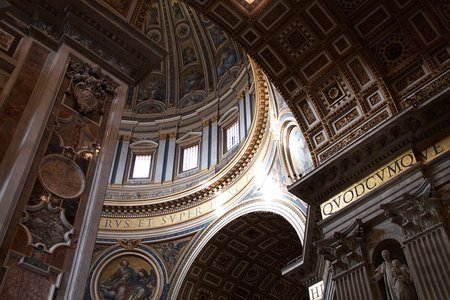
Then there is Veronica’s veil which contains the sacred image of Christ’s face. There is a piece of True Cross that was found in Jerusalem by Constantine’s mother Helena. Then there is Saint Andrews relic…he was the brother of saint peter. Each niche that surround the basilica interior has a giant statue of the saint associated with the particular relic.
Apse and Throne
The Basilica apse has a brilliant Baroque artwork that integrates the Cathedra Petri/ Chair of St Peter. The chair is literally wrapped in layers of bronze and is fashioned like a throne and flanked by reliefs from the fathers of the church; Athanasius and Johannes (Eastern Church) and Augustine and Ambrose (western church). The window above the throne is divinely pretty….many angels and cherubs surround it.
Tombs
The interior of the Basilica holds some impressive tombs that were created according to the instructions of some megalomaniac Popes (read the section on ‘Tragic & Dramatic Construction’ above to know more). The Pope Urban VIII tomb lies left to St Peter’s throne and was created by Giacomo Della Porta. Then there is Bernini’s creation; monument of Alexander VII. This shows the Pope praying in front of a skeleton that holds an hourglass. The monument is flanked by statues of virtues. The Tomb of Pope Innocent VII is another beautiful construct designed by Antonio del Pollaiolo. Incidentally this is the only tomb that made the journey from the original St Peter’s basilica to the new one.
Pieta
Arguably the most sought after attraction in the basilica is the Michelangelo created Pieta. This divine creation shows a young Mary holding the dead figure of her Son. Incidentally this was made around 1500 when Michelangelo was only 25; an indicator to the genius of the great sculptor. The statue has a ribbon that flows across Mary’s chest; Michelangelo has inscribed his name there.
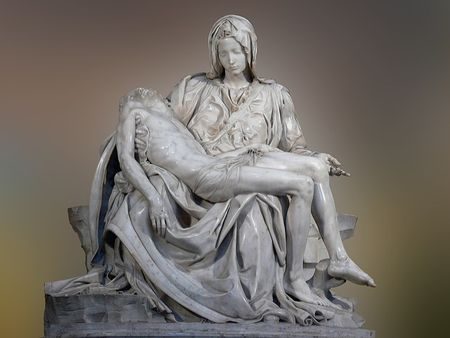
This work of art was unfortunately damaged in 1972 when a mad visitor hit it with a hammer….now a bullet proof case protects it. The statue is marvellously made from a single block of marble.
Artwork
The basilica interiors are dotted with dazzling artwork. However most of the paintings you see inside are replicas. The originals are mostly stored in the Pinacoteca Vatican. The excessive humidity inside caused mold infestations that damaged many of the original oil paintings which is why they were removed. The replicas are also beautiful like Stefano Pozzi’s mosaic that replicated Raphael’s ‘Transfiguration’ painting.
Many visitors to the Basilica are unable to comprehend that the images they see inside are not paintings but replica mosaics. The only painting inside the Basilica is located in the Chapel of Blessed Sacrament ….it is Pietro Cortona’s ‘Holy Trinity’. There are more than 33,000 square feet of mosaics inside. A large team of mosaic artists are continually engaged by the Vatican for the restoration and upkeeps of these mosaics. The team is called the ‘Vatican Mosaic Studio’!!!
Treasury/ Museo Storico Artistico
You will find the treasury entrance in front of the left transept. There are many sacred treasures here including many crucifixes. There is an entry fee and you should go only if ancient Christianity interests you. The 6th century Crux Vaticana and the Donatello Tabernacle are especially attractive.
This space is also referred to as the Caves and the spiritually inclined may like to think of it as a place of memory of the older original basilica as most of its relics are preserved here. Expect religious paintings, fragments of the lost church and remains of destroyed tombs here.
Sacre Grotte/ Grotte Vaticane/ Necropolis
Visiting this necropolis also requires a ticket. Graves of more than a 100 popes are contained here. This underground floor was formed when the new basilica was built around 3.2 meter above the old one. There is staircase near the Longinus statue which will take you to the Sacre Grotte.
This area lay buried and inaccessible for about 1300 years before it was discovered and opened to humans on select days. Most tombs are rectangular shaped with doors and terrace and often a wall. Many are beautifully decorated and some preserve mosaics and ornate frescoes apart from sarcophagi and stucco. Archaeologists and historians are still unsure of the original Tomb of St Peter which is said to have remained ‘inaccessible’ for over 2,000 years. At any rate visiting the hidden areas of the St Peters will surely inspire a spiritual déjà vu feeling as your mind struggles to register the enormous history of the place.
Open Hours, Tours & Tickets
The St Peter’s Basilica is open every day including all Sundays, Christmas, Easter and other special occasions. The basilica is open from 7.00 a.m. to 7.00 p.m. while the Vatican Grottoes/ Necropolis are open from 7 a.m. to 6.00 p.m.
Visiting the St Peter’s Basilica is free but there is a ticket for going up to the dome and for looking at the Vatican Necropolis. The Vatican Necropolis is only accessible when the Excavations Office grants special permission. Email scavi@fsp.va to see if you can get a reservation for your selected date; there is a cost of 13 euros per person.
For visiting the Cupola/ Dome (open from 8.00 a.m. to 6.00 p.m.) you have a choice of two tickets. There is a 10 euro ticket for going via the elevators and 8 euro ticket for going by the stairs. You need to climb 554 steps to reach the top of the basilica so physical fitness is necessary. If you take the elevator you can skip climbing 320 steps but still have to climb 231 steps to reach the top. The view from the top is superlative so don’t miss visiting the cupola.
You can find various options for entry and tours of St Peter’s Basilica (including combination tours with other attractions) and book online from this Viator site.
Points to Remember
The queues are quite huge and since this is a free attraction there is really no way to escape that. You can reserve your ticket with a tour group…that will help you skip the line. Many tourists think that the lines for entering St Peters Basilica will also make them gain entry into the Sistine Chapel; however the latter can only be entered through the Vatican Museums. However large be the crowds, the Basilica never appears crowded from the inside; its sheer size is a definite advantage.
You need to be dressed modestly for visiting the St Peter’s Basilica; wearing shorts, sleeveless dresses and short skirts are not allowed. Do remove your hat when you are entering the church. It’s better to avoid Wednesdays if you just want to visit the basilica. There is a papal audience or papal mass every Wednesday morning in St Peters Square and you won’t be allowed inside the basilica till the mass is over.
It’s advisable to travel light to the Basilica…security is stringent, it’s similar to being in an airport. Don’t try carry prams inside; they will have to be deposited inside the cloak room.
The security line stretches halfway across the square (usually) even if you arrive between 7 to 9 a.m. As the line grows in size, the security guys open more checkpoints.
If you are Catholic then try attending the mass or a ceremony like the sacrament of reconciliation; it will be a good experience. Arrive early as the basilica is a major attraction and is always full of people. Arriving at 8.45 a.m. is good. You will require at least 3 to 4 hours to admire the basilica and its ancillary attractions fully.
Location & Transport
St Peter’s Basilica is contained inside the Vatican City that’s across the Tiber River north to the city center of Rome. In case you use the Rome Metro you can disembark at the Ottaviano and then take a ten minute walk to St Peter’s Basilica via Ottaviano. Many city buses stop at Vatican City including the routes 64, 62, 81 and 40. Many hop on hop off buses drop visitors off at the Vatican City. In case you plan on bringing a car then you might use the 5 storey car park terminal Gianicolo that’s just ten minutes away.
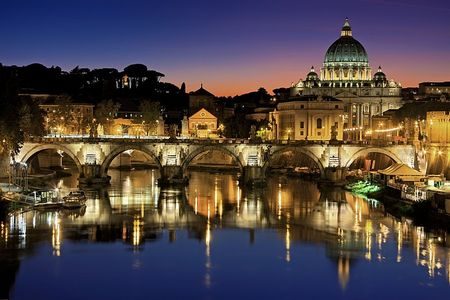
Kids under the age 10 can travel free on public transport. If you are planning to use public transport on Sundays then beware of road closures. The Vatican City is just a 20 minute walk from the historic centre of Rome so walking is a pleasant option. Consider combining your visit to the St Peters Basilica with Sistine Chapel and/ or Vatican Museum….they are right around the corner.
Address: Piazza di San Pietro, 00120 Vatican City. Phone: +39 06 6988 3731
Once you are done sightseeing at the basilica you might want to have a quick bite before you move on to your next destination in the Vatican City. For fabulous sandwiches (lots of vegan options too) try the Duecento Grade that’s on the Piazza Risorgimento… in between St Peter’s Square and the Vatican Museums.
Another great place for a quick eat is Via Verona that has Nan with its fantastic collection of bagels, yoghurt parfaits and salads. For a more relaxed meal try the pizza, pasta and bean based dishes at Bacio di Puglia on Via del Mascherino. For a fancier meal go to L Archangel that’s famous for its gnocchi….it’s on Via Giuseppe Gioacchino Belli that’s just 20 minutes away from St Peter’s Square.
 A travel addict. Still celebrating the day when he quit his high-profile corporate job to pursue his passion for travel writing.
A travel addict. Still celebrating the day when he quit his high-profile corporate job to pursue his passion for travel writing. 